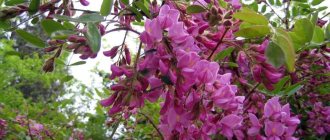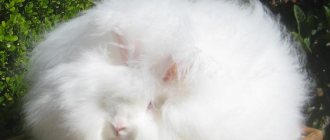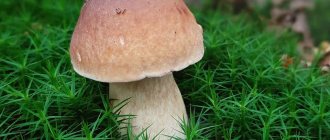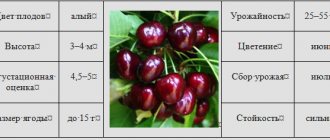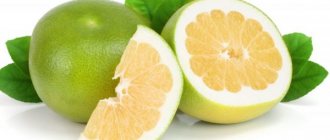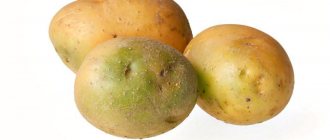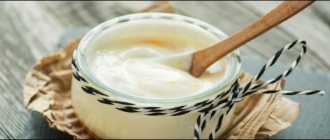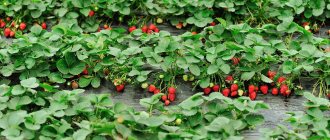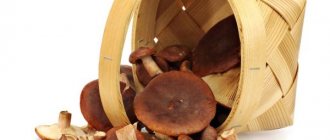Description of acacia honey
Acacia trees grow in the middle zone, subtropical regions and on the Black Sea coast of our country. In a short flowering period (1.5 - 2 weeks), in dry weather, bees manage to collect a useful harvest.
The difficulty of prey also lies in the fact that the insects have not strengthened after hibernation, so their ability to work is weak. The quantity and quality of the pumped product depends on this. One hive “produces” only 7–10 kilograms of acacia honey.
Interesting fact!
The honey plant tree is called “Robinia pseudoacaceae”. The biological name of the plant has not taken root in Russia, so it is called White acacia, and the shrub “Cargan arborescens” is a source of useful yellow “acacia honey.”
What does acacia honey look like?
Once collected, acacia honey has the density of water. Its color depends on the breed of honey plant, and can be translucent (white acacia), or lemon yellow with a greenish tint, if obtained from a collection in the Karaganda region.
The beneficial properties of the acacia variety are characterized by long-term crystallization. Throughout the year (depending on the impurities), honey remains transparent due to the reduced content of sucrose and the increased content of fructose, which is responsible for the process of thickening the liquid. The higher its content, the slower the crystallization occurs, which means the longer the beneficial properties are preserved.
Therefore, its cost is higher compared to other honey varieties. The acacia bee product, after “candiing”, takes on a white or light yellow color and a fine-grained structure, but even in this state it continues to retain active biological properties.
Composition and calorie content
The composition of acacia honey consists of 40% fructose and 35% glucose (a monosaccharide that is an important source of nutrition for the human central nervous system). The product contains vitamins A, B, C and D. The nectar is rich in minerals, including iodine, iron, copper, manganese and chromium. In addition, the bee product contains oxalic, folic, malic and tartaric acids, maltose.
The protein components of honey (from 0.5 to 1.5%) are microscopic insoluble suspensions (colloidal type), which can cause foaming when transfused.
There are no fats in 100 grams of delicacy, but it contains about 80% carbohydrates and 3% proteins. The calorie content of honey is about 440 kcal.
Taste of acacia honey
The pleasant aroma and delicate taste of acacia nectar have a unique blend of taste sensations. The amino acid complex of ingredients gives the taste of honey a unique “note”; it is not too sweet and has a slight bitterness.
NB!
The treat can be used as a sweetener for drinks, for example, added to tea or coffee. But it is not a sugar substitute, although it takes longer to be absorbed in the body due to the properties of fructose. Glucose and sucrose are the main source of calories in the sweet product, so those who want to lose excess weight should not use it in large quantities.
Storage
Since ancient times, it has been believed that wooden (preferably linden) containers are best suited for storing this sweet product. Oak will change color, aspen will add bitterness to honey, pine and spruce will give it the aroma of resin.
With the advent of glassware, honey began to be stored in it. In the open air, it thoroughly loses water, and with it its weight, which decreases by 4-5%. Therefore, glass containers must be tightly closed. Under the influence of light, honey loses all its beneficial properties, which is why it must be stored in a dark place. If the above rules are observed, it retains its beneficial properties for a year, and then simply turns into a sweet product.
Acacia honey beneficial properties
The composition of nectar, which belongs to monofloral representatives (collected from one type of plant), includes a large set of valuable substances and vitamins, so the acacia product is beneficial for human health.
The antibacterial activity of the substance, which contains compounds that produce and promote the gradual release of hydrogen peroxide (the active acid destroys the cell walls of bacteria), is one of the main healing qualities of nectar.
Important!
As a result of medical research, it was found that acacia honey is effective against Staphylococcus aureus and Pseudomonas aeruginosa, which are resistant to antibiotic therapy.
The beneficial properties of nectar restore microflora and heal the intestinal mucosa.
Honey strengthens the cardiovascular system and nervous system, fights insomnia and improves sleep quality.
Acacia honey is useful for colds. The property of nectar is to have antipyretic, antiviral and anti-inflammatory effects. For angina it is an effective antiseptic. It reduces pain in the throat and heals small wounds.
Acacia varieties have a low glycemic index (from the English glycemic (glycaemic) index or GI), an indicator that determines changes in blood sugar levels, and ranges from 40 to 45 units. In minimal doses, nectar (1 teaspoon on an empty stomach, and the second during the day) can be consumed by people suffering from mild to moderate diabetes.
In the absence of allergic reactions to the components, “bee medicine” is recommended for young children, weakened people and pregnant women, due to its immunomodulatory and general strengthening properties.
Types of acacia
Acacia is a member of the legume family. The characteristics of a given plant are determined by the species to which it belongs.
White acacia
Robinia has smooth, ovate leaves and white flowers that smell pleasant. The ripening period falls in mid-June. White acacia honey has beneficial properties: it treats gastritis and peptic ulcers, and is useful for disorders of the genitourinary system.
Yellow acacia
These are bright yellow flowers that bloom in late spring and early summer. The bush usually reaches 4 meters and is capable of producing about 100 kg of honey. This plant improves skin condition, eliminates excess weight, and defeats inflammatory processes in the body.
Applications of acacia honey
In folk medicine, all components of the waste products of bees are in demand, but honey is especially useful for inflammatory diseases of the respiratory organs.
Honey for colds
The collection from acacia contains many amino acids that help get rid of acute respiratory infections and viral infections. Due to the minimal pollen content in its composition, the laryngeal mucosa is not irritated in case of inflammation of the throat.
In the “piggy bank” of traditional medicine, there are a huge number of useful recipes for colds with the addition of acacia nectar. I take it separately, add it to teas or milk, and mix it with other ingredients. For example, tea with honey and raspberries is a strong antipyretic. It also increases sweating, removing the infection from the body along with the fluid.
Recipe "Honey and milk"
To remove phlegm, soothe sore throat, and make breathing easier, milk and honey are beneficial in the fight against colds.
- Heat 200 ml of milk to 69 – 70 °C, without bringing to a boil. Boiling water destroys beneficial substances;
- add one to two teaspoons of honey to the drink;
- Stir the mixture thoroughly until a homogeneous mass is obtained.
It is recommended to take the drink 30-40 minutes before bed, while lying in bed, as it has a relaxing and hypnotic effect.
"Honey, milk and garlic"
During the period of an acute form of the disease with high fever, garlic is added to the recipe. The benefit of the root vegetable is its high content of phytoncides (biologically active substances that destroy or suppress the growth of pathogenic bacteria). In combination with nectar and dairy product, it enhances the antimicrobial effect.
- 5 - 7 cloves of medium-sized garlic are pounded in a mortar until a paste forms;
- a tablespoon of honey is mixed with chopped garlic;
- milk (100 - 150 ml.), heated to a temperature of 40 - 60 degrees;
- All components are thoroughly mixed.
This composition is recommended for use 4 – 5 times a day after meals. If the drink is very bitter, or the patient has concomitant problems with the gastrointestinal tract, it is washed down with a small amount of warm milk.
In the composition of the medicine, garlic can be replaced with squeezed juice from half a lemon. Vitamin C contained in lemon has an antioxidant and tonic effect on the body.
Reduces blood sugar levels
The minimum content of sucrose against the background of a large amount of fructose gives the acacia product the ability to lower “harmful” sugar in the blood plasma. In terms of its composition, sweet food in moderate doses is an ideal product for people with diabetes.
Another form of problem with blood sugar problems is its sharp decrease, which leads to a serious illness - hypoglycemia. To maintain the vital balance for normal hematopoiesis, it is recommended to take it strictly under the supervision of a physician.
From pressure
Hypertension is primarily a disease of the nervous and cardiovascular systems. According to neurologists, taking a small amount of sweets under the tongue irritates the taste buds, which excite the parts of the central nervous system responsible for pleasure. Then, from nervous internal organs and muscles to relaxation. As a result, the person calms down and his blood pressure (BP) decreases.
Nectar cannot be the only remedy in the treatment of cerebral hypertension. In folk medicine books there are recipes that, based on acacia bee products in combination with drug therapy, reduce intracranial pressure.
"Honey and dried fruits"
Dried fruits are rich in vitamins and microelements. Mixing with nectar enhances their benefits for the body.
- Grind dried apples, dried apricots, prunes and walnuts in a mixer until powdery;
- Add the juice of one lemon;
- Mix the composition with 3 tablespoons of honey.
After the mixture has been infused for a day in a dark, cool place, it can be taken in between meals 3-4 times a day.
For depression and stress
Depressive states and stress caused by an accelerated pace of life, minimal physical activity, and hereditary factors cause a person to become apathetic and lose interest in life. Seasonal factors (autumn - winter) aggravate unpleasant symptoms.
In the initial stages of the disease, you can do without drug intervention. A sweet treat made from acacia flowers, which consists of “fast” sugars, will help cope with ailments and reduce anxiety.
Tinctures and herbal teas based on honey lift your spirits and soothe. For example, a drink brewed with ginseng or Chinese lemongrass quickly restores energy.
A charge of vivacity and a stable emotional state will be provided by simple water, half a teaspoon of natural royal jelly and a teaspoon of nectar, drunk 15 - 20 minutes before meals. The composition is drunk for a month, but the positive effect will be noticeable after 3 to 5 days of taking it.
To improve vision
Eyes are very sensitive organs. Honey therapy is beneficial for improving the health of visual receptors thanks to a complex of vitamins, microelements and amino acids, among which folic and pantothenic strengthen visual acuity.
Instillation relieves dryness and irritation of the eye mucosa, has an anti-inflammatory and anti-allergic effect. Acacia honey in the form of diluted drops prevents the development of glaucoma, leading to vision loss.
Applications based on a bee product for such problems in ophthalmology as blepharitis, conjunctivitis, glaucoma, dry mucous membranes as a result of working at a computer (prolonged stress).
Important!
For eye therapy, it is necessary to adhere to the strict instructions of a specialist and place high demands on the quality of the “medicine”.
Firstly, honey must be fresh.
Secondly, do not contain sugared inclusions,
Thirdly, the ophthalmologist should decide what liquid to use to prepare the drops.
The honey water recipe will help prevent inflammatory processes, normalize eye pressure, and eliminate dryness and burning in the eyes.
Pour a teaspoon of nectar into a glass of filtered water;
boil the composition for two to three minutes;
Cool the liquid to room temperature and apply to your eyes as a lotion. You can use sterile cotton pads for this.
The compress can be kept on the eyelids for about 20 minutes. It is recommended to repeat the procedure 2 times a day.
For the immune system
Acacia bee product is a powerful immunomodulator. It replenishes the deficiency of vitamins and microelements, which strengthen the body during the “period of colds”, and facilitates recovery during seasonal illnesses.
Benefits for the stomach
The use of folk recipes for diseases of the gastrointestinal tract gives positive results in combination with medications. Gastroenterologists note that the wound-healing properties of the acacia product contribute to scarring of ulcers, reduction of pain in the abdominal part of the body, and enzymes and carotene help good digestibility of food.
For the liver
The liver performs a complex and useful function of cleansing the body of waste and toxins, especially during the holidays, when the menu consists of “heavy” foods and alcohol.
Nectar restores organ tissue affected by cirrhosis or fatty hepatosis. Only gastroenterologists can prescribe auxiliary therapy.
Acacia honey in home cosmetology
Recently, women prefer to take care of themselves at home. This saves time, and you can stock up on environmentally friendly products in specialized stores or pharmacies.
Benefits for the skin
In cosmetology, nectar from “Robinia pseudoacaceae” is included in home and factory-made medicinal and cosmetic products: creams, masks, lotions. The preparations have a pronounced moisturizing effect, smooth out wrinkles and help prevent the appearance of new facial defects.
An important function of cosmetics is nutrition and antiseptics. Honey penetrates deeply into the skin pores and saturates the dermis with beneficial substances, and the wound-healing properties of the product relieve irritation and eliminate inflammatory processes.
Face masks
It's easy to make healthy face masks at home using simple ingredients.
Among facial skin care products, according to women's reviews, masks in combination with a honey product and ingredients that suit their skin type are effective. You can choose the right option yourself on the Internet. Cosmetology websites present dozens of anti-aging recipes based on acacia honey.
Hair masks
Regular masks made from acacia bee products accelerate hair growth, reduce hair loss and fragility. Hair damaged by frequent color changes and perms can be easily restored.
If you mix a slightly melted tablespoon of honey and add a raw egg, mix the mixture thoroughly, apply it to your head and cover your hair with a plastic bag, and then rinse with warm water, as a result your hair will look like after a visit to a beauty salon.
Body scrubs
Experimenting with the production of skin peeling based on the acacia ingredient will allow you to gently and deeply cleanse the pores on the skin of the body. Sea salt or coarsely ground coffee will add beneficial properties to the scrub.
To avoid drying out the skin, dermatologists recommend performing this procedure no more than twice a week, and then lubricating the body with a nourishing cream.
Use of acacia honey in cooking
Acacia honey is actively used by housewives for baking pastries, cakes and pies. The wonderful aroma of nectar, its beneficial properties and its specific taste can turn flatbreads made from simple dough into a culinary masterpiece.
For women who are prone to excess weight, the ingredient is an excellent solution to enjoy culinary delights without gaining extra pounds. Nectar contains no fats, a small amount of protein, and the bulk consists of carbohydrates.
Description and composition
According to the characteristics of beekeepers, this product may have a shade of light yellow or white. Bees collect nectar from two acacias: white and yellow. The beneficial properties of these products are identical, but the taste of the white variety is much more subtle.
In appearance, the acacia product is light, transparent, and slightly sour in taste. It emits a subtle floral aroma and can remain liquid for a whole year. If the crystallization process occurs, the honey will turn milky white. When consuming the product, you can feel a light and pleasant taste reminiscent of vanilla.
It cannot be called a low-calorie product, although it does not contain natural fats. This product contains a lot of useful substances. In addition to vitamins A, K, B, E, H, it contains trace elements and minerals:
- Copper, chromium, silicon and others.
- Folic, pantothenic, nicotinic, ascorbic acids.
- Glucose with fructose.
- Organic acids.
- Flavonoids.
- Polysaccharides and monosaccharides.
- Nitrogen compounds.
- Phosphorus, calcium, iron, zinc, potassium and other minerals.
Contraindications
Among the different varieties of honey, acacia honey is considered hypoallergenic, low in calories and easily absorbed by the body. You can list many benefits of this bee product, but there are a number of people for whom it is contraindicated:
- Patients suffering from severe diabetes mellitus.
- People prone to allergic reactions to honey or some of its ingredients.
- Infant children.
With caution and in small doses, you can start feeding babies aged two years and older with acacia honey. A large amount of honey can damage tooth enamel due to its sucrose content and, instead of being beneficial, can cause harm to the child.
Peculiarities
This variety differs from the others in that crystallization takes quite a long time, thereby keeping it in a liquid state. At the end of spring, bees begin to collect nectar, and the collection process lasts until the end of June. This variety is produced in the southern part of Russia, since the climate of the southern regions is the most optimal for plants to continuously produce nectar.
The medicinal properties of the delicacy are due to the unique composition of acacia, which is why this variety is so highly valued among a huge number of honey lovers.
- The color depends on which plant the nectar was collected from. The plant is white and yellow. The product is colorless when collected from white acacia. It is distinguished by transparency and purity. Yellow acacia honey has a pale yellow, sometimes pale green color.
- The dull color of this variety is the reason that people often confuse it with a fake product. Acacia honey is distinguished from fake honey by its unsurpassed aroma and color.
- The smell is light, acacia can be felt well in it. Beekeepers note that the aroma of this variety has absorbed all the best from the plant, but it also contains ascorbic acid.
- The delicacy has a pleasant, delicate taste, devoid of bitterness.
- The fresh, natural product has a very liquid consistency, reminiscent of water, but after a few days it acquires some thickness and viscousness. The product crystallizes slowly. After this process is completed, it becomes white, with small crystals of sugar, which are difficult for a person to distinguish.
Acacia honey does not lose its healing properties after crystallization, which is its great advantage. This variety does not cause allergic reactions, so everyone can enjoy its unique taste and aroma in moderate doses.
See also
The benefits and harms of maple honeyRead
How to distinguish real acacia honey
The nutritional value, beneficial properties and high cost of acacia nectar push unscrupulous beekeepers to counterfeit the product. They may offer expired goods or “pure” acacia honey mixed with other types.
The article has already described how a natural acacia product should look and smell, but a simple chemical experiment will give a 100% guarantee of quality: the blueness of the nectar will indicate thickeners or additives if you add 2-3 drops of iodine to the composition.
How to choose?
In the market, unscrupulous sellers often sell counterfeit goods. Therefore, you can easily make a mistake when purchasing. Real honey should be transparent, with a golden tint , without a pungent odor or bitterness, and without sediment or turbidity. If you dip a stick into it and then pull it out, it should slowly drain and form a slide, which then gradually levels out. Natural honey does not contain any additives.
During the purchase, you can conduct a test, for this:
- 1 tsp. Place honey in a bowl and add 1 tsp. ethyl alcohol.
- Mix the ingredients and look at the sediment. If it is absent, then the product is of high quality, and if it is present, then flour, starch or chalk was added to the honey.
